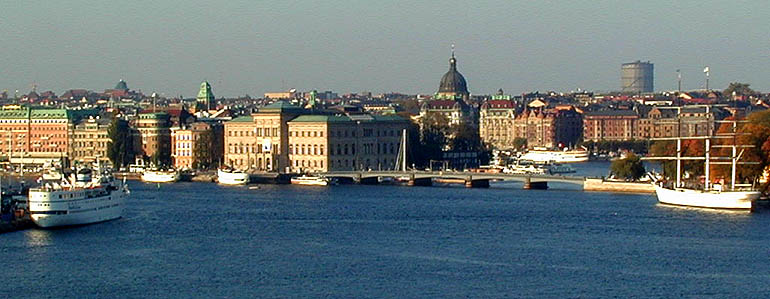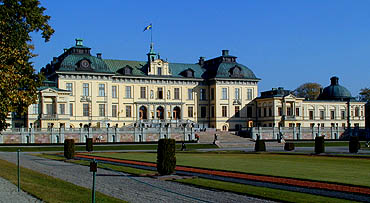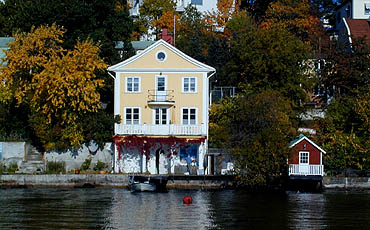 |
 |
Like a sparkling stone within a diamond cluster, Stockholm's old town sits on one of 24,000 islands in a unique and beautiful archipelago along Sweden's coastline. Situated in the center of the channel linking the Baltic Sea with Lake Malaren, Stockholm developed into an ideal strategic settlement. Birger Jarl built the original fortress during the 13th century to control shipping traffic between the freshwater lake and the sea, and to protect inhabitants from pirates. The oldest known portrait of the city, pictured above, hangs in the cathedral. It depicts a light phenomena of six rings with solar halos that occurred over the city on April 20, 1535. For many years to follow the city's primary importance lay in its role as a trading center. From 1611 until 1721 Sweden dominated northern Europe and controlled parts of Norway, Finland, Denmark and northern Germany. During this period Stockholm would grow into the country's capital center. Today 1.6 million people live in the city of Stockholm, which spreads far across numerous islands.
 |
 The existence of this amazing archipelago and Stockholm's intrinsic watery environs took us by surprise. Lovely boulevards with great turn-of-the-century architecture play backdrop to a harbor filled with beautiful boats. Gamla Stan, the old town island, lies in the center, testament to the city's origins. Wonderful aged structures with shops and restaurants occupy the enchanting narrow streets of this protected area. Small cobblestone squares provided turn around space for carriages. Visitors can watch the changing of the guard at the Royal Palace, or have coffee inside the building where the Nobel Prize for Literature selection unfolds.
The existence of this amazing archipelago and Stockholm's intrinsic watery environs took us by surprise. Lovely boulevards with great turn-of-the-century architecture play backdrop to a harbor filled with beautiful boats. Gamla Stan, the old town island, lies in the center, testament to the city's origins. Wonderful aged structures with shops and restaurants occupy the enchanting narrow streets of this protected area. Small cobblestone squares provided turn around space for carriages. Visitors can watch the changing of the guard at the Royal Palace, or have coffee inside the building where the Nobel Prize for Literature selection unfolds.
A walk across one of the many low iron bridges leads up to the heights of the Soder district. On Fjallgatan street, which runs atop a cliff along the waterway, we found terraced gardens, 300-year-old houses, narrow stairways, and fantastic views across the harbor. The island of Djurgarden forms part of the Stockholm National City Park, the only one of its type in the world. It houses a number of museums, including the Skansen and Vasa Museum. The world's first open air museum, Skansen opened in 1891 to show an increasingly industrialized society how people once lived. About 150 houses and farm buildings relocated there from all over Sweden, portray the life of both peasants and landed gentry, along with Lapp culture. At the Vasa Museum, a large royal war ship of the same name reveals the tragic story of its poor design. Built with two gun decks, insufficient ballast space, and not enough width, the ship tipped over soon after its maiden voyage, and sunk in 1628 in the city harbor. Following a four year salvage operation, the ship finally arrived in dry dock on April 24, 1961. Since, it has been restored to 95% of its original appearance.
 |
Large ocean liners, double masted sailboats, old fashioned steam ships, small water taxis and an assortment of other vessels provide many excursion possibilities. On our return from the National Museum we spontaneously boarded a steamer from 1911 for a three hour dinner cruise. We ate delicious traditional dishes of fish and meatballs, and finished our fine meal with Swedish punch, the local digestif. During the cruise two bands played a variety of Swedish folk and modern music. In the engine room the pistons could be seen churning in their oils, while the crew shoveled coal into the belly of the beast. On deck we wrapped ourselves in large wool blankets to keep off the night cold, and gazed at the lit city and stars.
Two more boating excursions took us to the island of Finnhamn, far out in the archipelago, and to Drottningholm Palace on Lake Malaren. Most of the islands near Stockholm are inhabited by either single luxurious homes with private dock and yacht, or by small communities of waterfront abodes with cute stores, cafes and boat service. Bridges and car ferries connect many of the closer islands. We hiked for hours through the low forest and over the smooth rock formations on tiny Finnhamn island. The sole sounds of wind, water and birds attest to its remoteness. At Drottingholm (below left) we toured the elegant reception rooms at the royal palace, and visited one of the worlds oldest working theaters, dating from 1781. The original stage machinery still remains in perfect condition, and drives scenery changes and provides sound effects for regular summer performances.


As the seat of a royal house with long-standing traditions, Stockholm's surroundings offer many other palaces and castles built for his majesty's many family members and various amusements. The plentiful collections of treasures from many centuries are now displayed within palaces or in the city center's many fine museums. The Historical Museum houses the famous Gold Room with some of the richest gold finds in the world. Other rooms display interesting artifacts from the Viking tribes and explain the cultural traditions of these seafaring folk.
We also enjoyed exploring current life styles in the small villages with their colorfully painted wooden homes (above right) or among the elegant houses in Stockholm's busy streets. The good life in Sweden is very expensive, even for dollar exchangers. Hotel and restaurant prices often seem unjustified. Nevertheless, the city welcomes its visitors with charm, perfect English and an abundance of historical and cultural treasures. And while boating along the many islands, we realized just how similar New England's coastline and villages look to the landscapes and architecture in Sweden. A call to home - and to our next destination?!